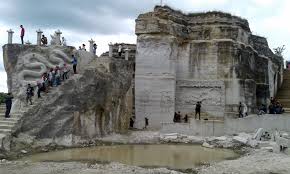SLEMAN - Who would have thought that towering giant, majestic and captivating boulders that are now one of the hit destinations in Yogyakarta Special Region (DIY) were formerly a mine site.
Breksi Cliff located in Groyokan Hamlet, Sambirejo Village, Prambanan Sub-district, Sleman Regency is a rock cliff that has been mined by the community since the 1980s.
This stone is used as the foundation of the house, walls, wells, and so forth.
The mining stopped in 2013. The change began when a conservation team consisting of the DIY Local Government and researchers from UPN "Veteran" Yogyakarta (UPNVY) published a discovery that said Breksi cliffs were volcanic ash deposits of ancient volcanic eruptions.
Breksi cliffs are then included in the list of geological heritage sites. It means that the former mine cliff is a site or geological area that has important values ??in the field of science, education, culture, and aesthetic value. Finally at the end of May 2015, Breksi cliffs was inaugurated as a tourist attraction.
A research report titled Geoheritage Yogya, Geoheritage Babad Bumi Mataram, Revealing the History of Geology, Babad Tanah Jawi (2014) compiled by Geoheritage Team of Geological Engineering UPNVY describes the glory period of Ancient Volcano during the Middle Miocene Oligocene about 16-36 million years ago.
The drafting team consisting of UPNVY Geologists Dr C. Prasetyadi, Prof. Dr. Bambang Prasthistho., Dr. Jatmika Setiawan, Ir. Achmad Subandrio, MT., and Adi Sulaksono, ST. MSc., explained that Java Island which was a unification between the Sunda exposure plate and the microcontinent of East Java was 'hit' from the South by the Indo-Australian plate that shifted to the North and pierced the trench zone in the south of Java to the West - East.
"This event is the main event of the history of the formation of the island of Java, the process of forming volcanoes in the southern part of Java Island which becomes the backbone of Java," said Jatmiko Setiawan, one of the researchers when found in UPNVY Campus, Condongcatur , Wednesday (23/05/2018).
Lecturer of Geology Engineering explained Breksi cliff (Breksi Tuf) is a pile of volcanic ash from the most powerful eruption of Semilir Volcano about 15 million years ago, its thickness reaches 300 meters. The spread out of volcanic ash to the East to the west of Gajahmungkur Reservoir, to the South to Australia to the North and to the West to Johor Malaysia. After that, a new volcano emerged in the middle of its caldera called Nglanggran Volcano in Gunung Kidul.
"The thickness of the volcanic ash pile at the famous Ijo Temple was known as Tebing Breksi (Breksi Cliff). This is the thickest in the whole world, the remaining mining is about 40x150 meter, we delinasi (atau delineasi = delineation ) it become one of Geosite in Jogja Geoheritage, "he said.
In addition to Breksi Cliff, UPNVY Geological team also found that there are 8 other sites or rock outcrops that have important geological values. The discovery of UPNVY Geological Team was then confirmed by the Ministry of ESDM through Decree (SK) of Determination of 9 Geoheritage Conservation Area in DIY. The Nine Geosites are Gamping Eocene, Lava Bantal, Breksi Tuf (Sleman), Ancient Nglanggan Mountain, Fossil Burrow Ngalang River, Mount Batur (Gunungkidul), Parangtritis Sand Reservoir (Bantul); Kiskendo Cave, and Mangan Kliripan (Kulon Progo).
"We submitted the 9 Geosite points to the Minister of Energy and Mineral Resources this year to serve as Geological Nature Reserve (KCAG)," he said.
The submission of such geosites as Geological Nature Reserves (KCAG) was to obtain protection (conservation), so it can be used for tourism functions, education, sustainable development and can improve the economy of local communities.
Community Impact
Jatmiko acknowledged that after the discovery of the Breksi geothermal site was set by the ESDM Ministry, the regional government and researchers conducted persuasion to the community regarding the termination of mining. At that time, the public reaction was not good, since the livelihood that was occupied disappeared.
"We went directly and it was in 2014. We succeeded in having Sultan HB X to Breksi Cliffs to seduce people to stop the mining," he said.
Despite the doubt, the residents are still willing to fight to change the location of the former mining area became a representative place of a tourist destination. Now the people who used to be a stone miners turned the profession into a tour guide.
"At first, it was difficult, but because we are diligent accompanying Sleman Tourism Office to always provide socialization of Geoheritage and the establishment of tourist areas, it finally succeeded. Their income has now reached 3-4 millions rupiahs per year, which they once sold stones for only 250 thousand rupiahs per truck, "said the lecturer
Once used as a tourist attraction, Breksi Cliff attracts many tourists. The visitors can reach 500 people on Monday to Friday. The number of visitors reaches 1,500s on Saturday-Sunday since January 2016.
When visiting Indonesia in June 2017, Barack Obama also had a visit to Breksi Cliffs. Breksi Cliff recently won the Favorite Top New Tourism Places category at the Indonesian Charm Endeavor event held by the Ministry of Tourism in 2017.
Learning from the success of Breksi, Jatmiko and UPNVY Geological team is now accompanying the Government of South Kalimantan Regency to prepare the Mereatus Mountains to be a National Geopark. (wwj / humas)
photo source: www.wisatayogyakartamagelang.id
Jl. SWK 104 (Lingkar Utara), Condongcatur, Yogyakarta 55283 (Kampus Pusat)
Jl. Babarsari 2 Yogyakarta 55281(Kampus Unit II) | Telp. +62 274 486733



